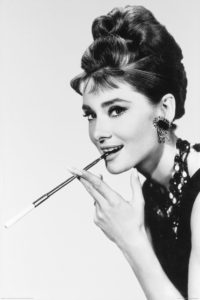Alain Rousseau’s work
by Patrick Neithard (*1971), cultural critic from Zürich, Switzerland.
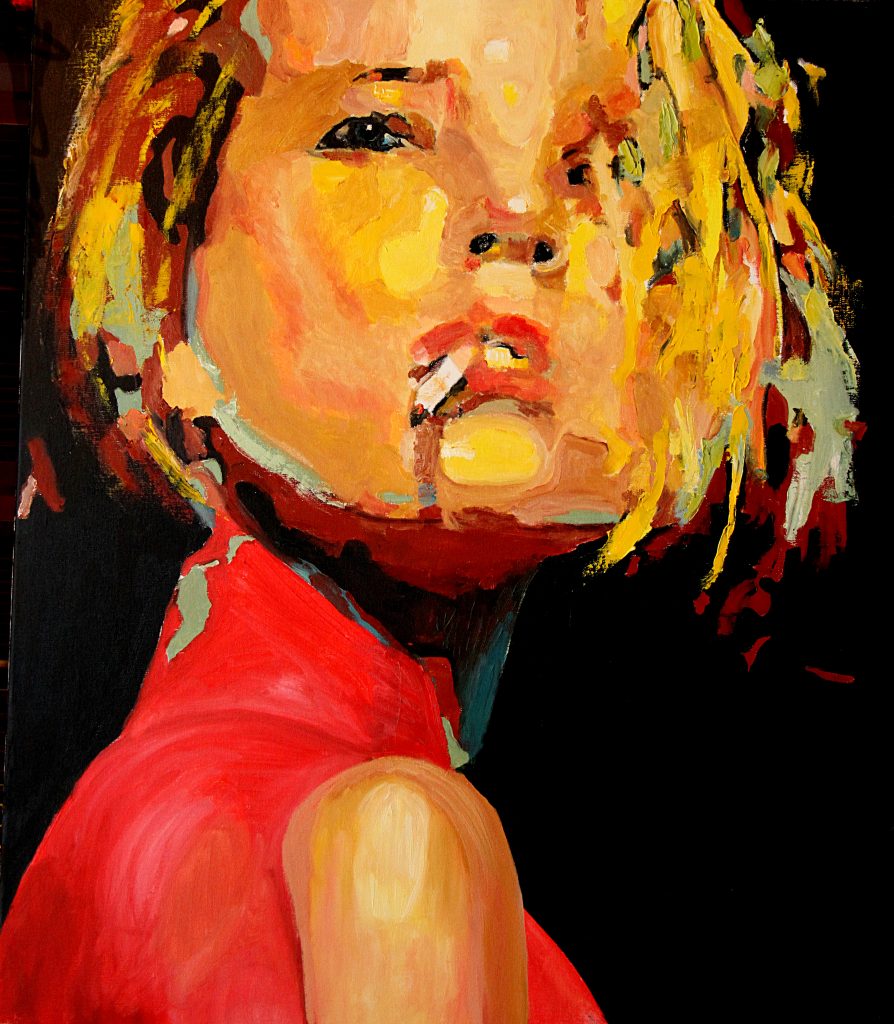 Copyright Alain Rousseau, La dominatrice (The dominator) oil on canvas, 100 x 120 cm, 2014
Copyright Alain Rousseau, La dominatrice (The dominator) oil on canvas, 100 x 120 cm, 2014
When artists like Alain Rousseau paint women in oil, and cocks, and horses, one might search for a deeper explanation. In the most obvious, they can only stand in competition. And yet, throughout Alain Rousseau’s works he is a portraitist linking portrait with striking poses.
There lies a Freudian ambiguity of perception within the portraits of the smoking women. They all seem familiar, well known and not only due to their format do they seem close. One seems to be languishing, lasciviously. The next appears agile, light, in her slender, yet heroic and ageless attitude she seems to be able to throw off her own vindication by time. And yet another contemplates, one hand is holding a cup of fuming tea, while the other hand holds that other fuming thing, the burning cigarette, and all the while her look seems to be jolted to someplace where she might just come back right this minute from, maybe from the past, or from the future. And only by the addition of that cigarette one knows that this is not draft for some tea brand advertisement.
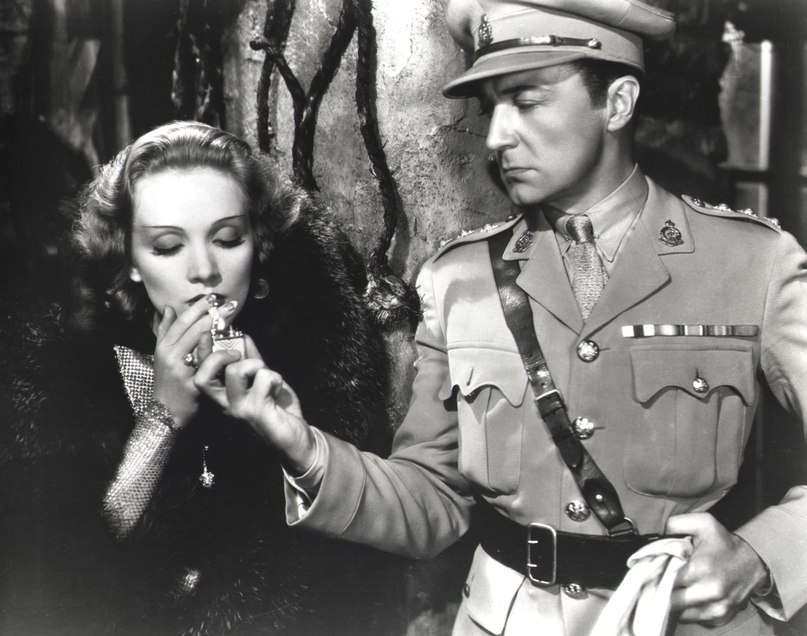 Marlène Dietrich and Clive Brooks in Shanghai Express by Joseph von Sternberg 1932
Marlène Dietrich and Clive Brooks in Shanghai Express by Joseph von Sternberg 1932
 Lauren Bacall in To have and to have not by Howard Hawks 1944
Lauren Bacall in To have and to have not by Howard Hawks 1944
The image of the smoking woman is more than just fetish. One might dive into the western image pool only to retrieve millions of images of the smoking woman. In 1932 it was the ice cool blonde Marlene Dietrich in “Shanghai Express” asking to be lit up. In 1944, a nearly wicked Lauren Bacall asks Humphrey Bogart in “To Have and To Have Not”, the same question in an establishing shot that could not have been more rural, yet it was that scene which would ignite not only their relationship in the movie, but also behind cameras. It must have been that divine spark. The image of the smoking woman has left an imprint in the western visual culture. Not only independency, luck on a grander scale or the feeling of stupendousness should accompany the moment in which the act of smoking is transferred into the means of expression. And it is almost as if the persona by means of spirituality and emotionality was reaching out for the sublime, sometimes accentuated, drawling, or in cutesy fashion. And that by holding a piece of paper containing a little tobacco, all lit up in an instant in order to breathe in and exhale the sublime. Be it a goodbye, an arrival, or maybe the gasping of full consequences, as soon as lips were touching the cigarette filter possibly even in a close up, it still is as if everything becomes vibrant with psychological tension.
Audrey Hepburn dans le film Charade
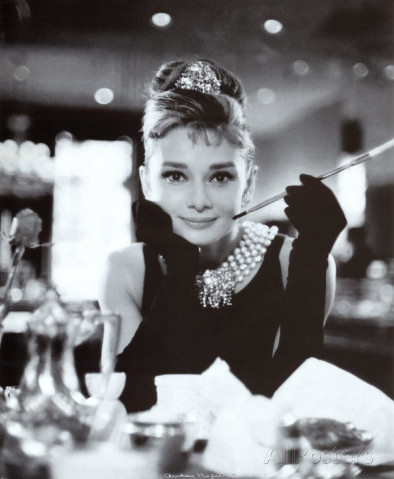 Audrey Hepburn in Breakfast at Tiffany’s 1961
Audrey Hepburn in Breakfast at Tiffany’s 1961
This image would culminate in such portraits of highly sophisticated characters like Audrey Hepburn in the 1963`s “Breakfast at Tiffany’s”, where she appeared in a black cocktail dress, her long, elegant and fragile arms mounding in an even longer cigarette holder, as if painting circles of smoke into the air. Still, this rather conformist image of the smoking woman changed drastically when the sexual revolution set in around 1965.
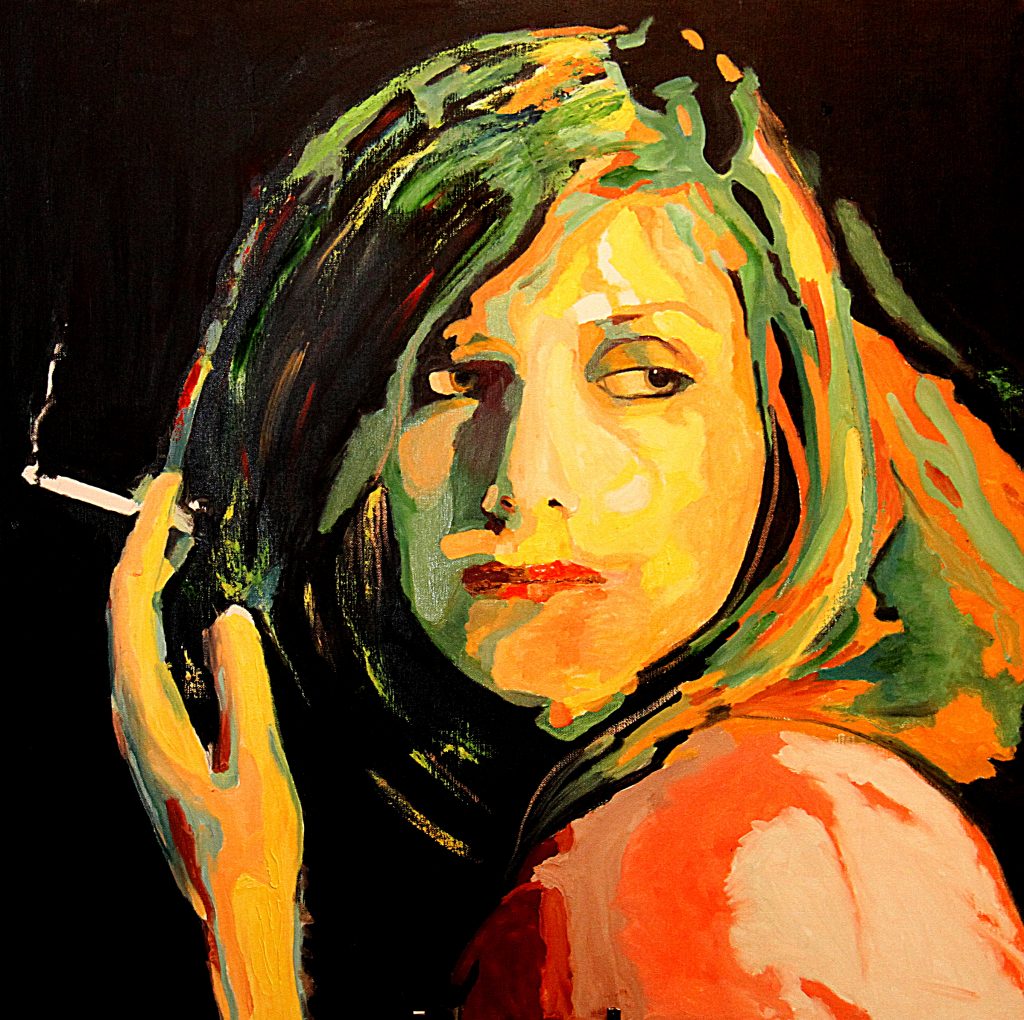 Copyright Alain Rousseau, Je t’ignore (I ignore you) oil on canvas, 100 x 120 cm, 2014
Copyright Alain Rousseau, Je t’ignore (I ignore you) oil on canvas, 100 x 120 cm, 2014
Between Time and Velocity, between form and Sublime.
Alain Rousseau studied painting in the early 1960ties. Painting, watercolor, architecture and cultural theory as such did not suffice to satisfy his father’s worry about a solid and nurtured future, which is why Alain Rousseau consecutively enjoyed a higher education in communication and the media. And it seems it was almost this which fortunately would bring him to harbors where he saw these divas, anchoring in these harbors of the public, in the limelight, hovering in front of the mass like flagships bringing the promise of a better, a brand new time. Other-wordy they may have seemed, majestic maybe, but during the sexual revolution those women unhinged their arms as accompanying beauties of the male, they became independent. They evolved into future portraying characters nobody should ever forget, to form looesly and more freely what constitutes a visual culture, a popular culture which until today is still evolving. And smoking, during the 1960 and 1970ties was paramount. Not only was there the smoking actors glide. Politicians of highest ranks smoked in talk shows, journalists and photographers alike, almost the whole world seemed to blow smoky circles into the air as if in search of something higher, something mythical, transcendental. Nobody seems to bother about the medical downside of smoking, its possible harms. Smoking as an expression of freedom, or the “laisser-faire”. Jeanne Moreau once was quoted that “Men who quit smoking appear uncanny to me”. Still, society started to change, and since the mundane evolved further away from world war two, the signals of smoke, that communication with the sublime, seemed to change.
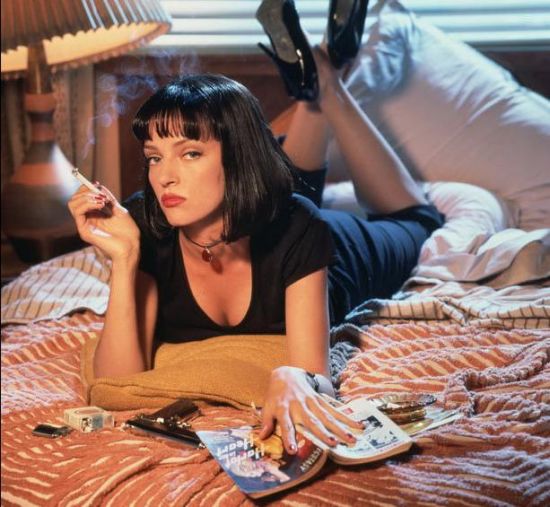 Uma Thurman in Pulp fiction 1994
Uma Thurman in Pulp fiction 1994
It was 1994 when the cigarette in the hand of Uma Thurman in “Pulp Fiction” symbolized rather the soothening of her anxiety while waiting for her ultimate consumption of cocaine, than connecting herself to the sublime by smoking itself. Even more, it seems as if within such moments the exorcism of smoking as it had been must have set in.
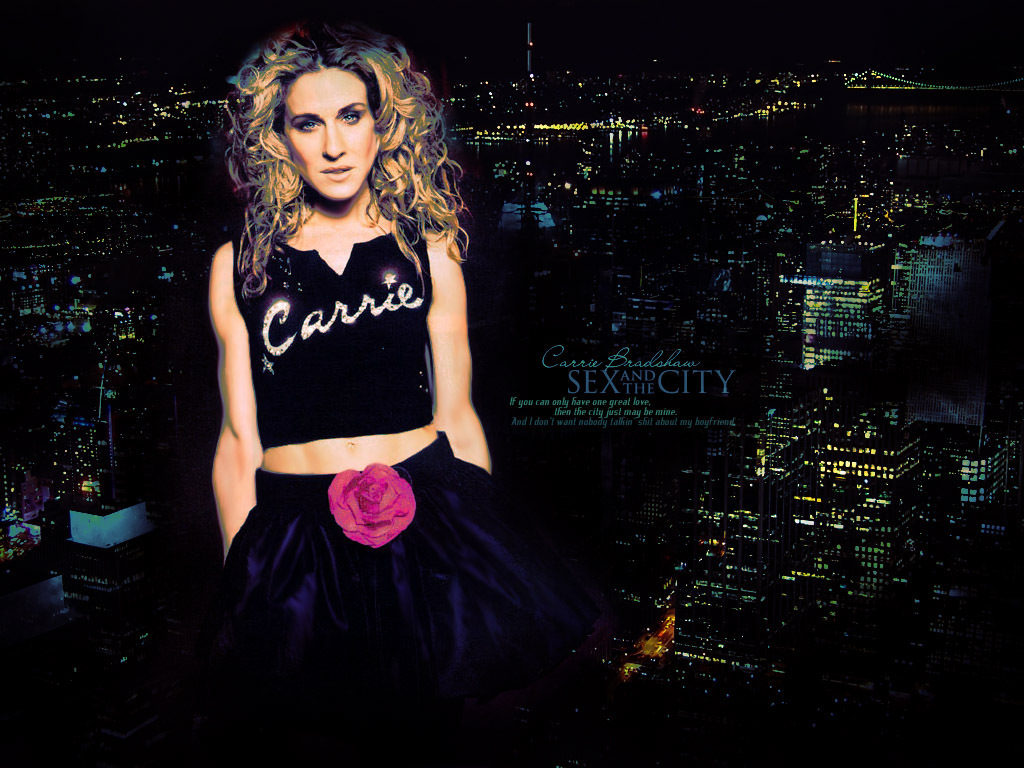 Carrie Bradshaw in Sex and the city by Darren Star
Carrie Bradshaw in Sex and the city by Darren Star
 Penelope Cruz in Vicky Cristina Barcelona by Woody Allen 2008
Penelope Cruz in Vicky Cristina Barcelona by Woody Allen 2008
At the turn of the millennium, the successful feminist series “Sex & the City” portraits its main character Carrie while she quits smoking, and since then it seems to be that only James Bond is still maintaining his strict dress code which would demand for such rites as smoking. Still, until this day, smoking remains an addition to the expression, even if it has been marginalised into such rather hysteric, bohemian characters as Penelope Cruz` in the 2008 ménage à beaucoup “Vicky Christina Barcelona” by Woody Allen. Smoking, here, has become a haptic imitation of a lifestyle or a decade which is revisited instead of lived, almost as if the pose is a dress worn for a day, on special occasions, moments of love, of admiration, rekindle the spirits of invisible but formidable bonds between people. In either case, there is a time reference as an immanent quality. And time is always linked to memory.
From the darkroom of the soul into bright colors.
If one wants to keep together fractures of time, in painting, this can happen as in Alain Rousseau`s paintings. His technique, the “Chromobscur” leans loosely on the classic painterly tradition, as it contains both the meaning of the chiaroscuro and the Greek word for color. While in chinese traditional painting there is always a white space in order to invite the spectator into the painting, ( and the french painter Paul Cezanne, whose works consist of many canvases with such white spaces, hence he was also named the “incomplete” or “unaccomplished”), Alain Rousseau frames his smoking women’s faces with smoke. You may enter by looking for the eyes behind that veil, as this is also Alain Rousseau’s classic way to construct any of his portraits. He is beginning the painting with the eye. Although mostly contrasted by dark colors, these vibrant faces connect by their colors, evoking each by each their persona through each individual choice of a color palette. And yet, any of these colors, if we see all portraits next to each other, just flow out of the very same artistic source.
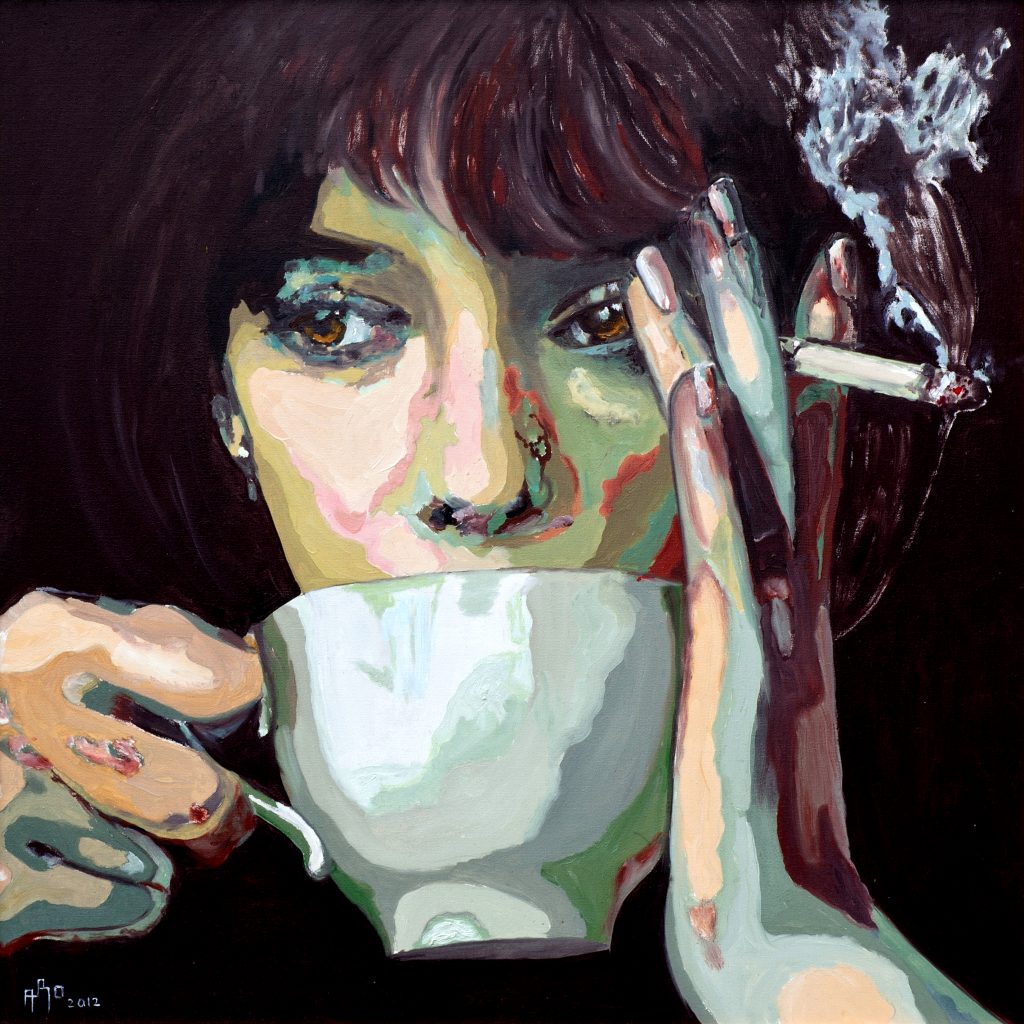 Copyright Alain Rousseau, Un café d’aube (An early morning coffee), oil on canvas, 80 x 80 cm, 2012
Copyright Alain Rousseau, Un café d’aube (An early morning coffee), oil on canvas, 80 x 80 cm, 2012
And while they all stem mostly from the artists memory, or are sometimes inspired by magazine photography, they seem to be brought to light by the act of painting them out of the dark. Memory here works as a transmutation, it is embedded in each one`s own vision and is heralded simply by watching and bringing together what we carry with us individually. Hence, they stem out of memory and out of a collective pool of images just as much. These acquaintances may have been brief as a flirt, short as a shared cigarette only, however they are brought to longevity in painting.
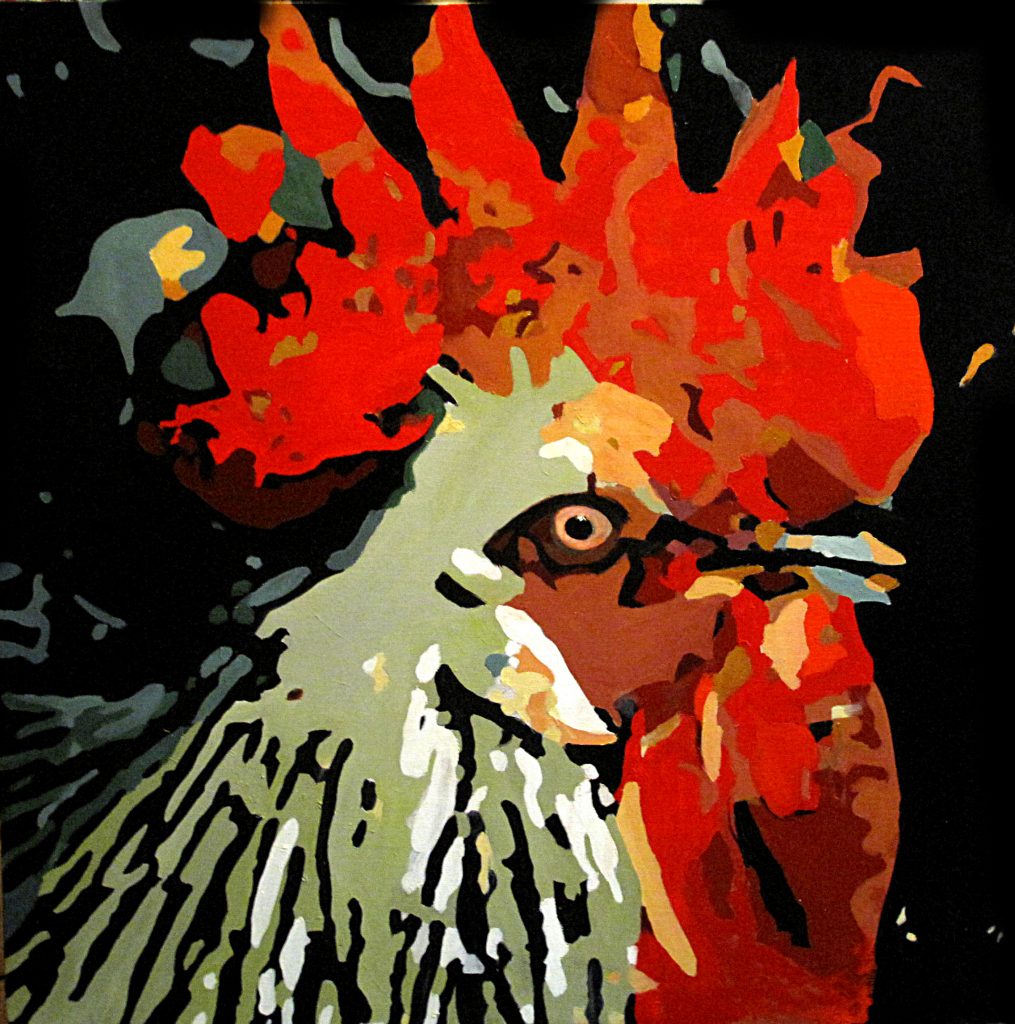 Copyright Alain Rousseau, Le roi des poules (King of hens) on canvas, 80 x 80 cm, 2014
Copyright Alain Rousseau, Le roi des poules (King of hens) on canvas, 80 x 80 cm, 2014
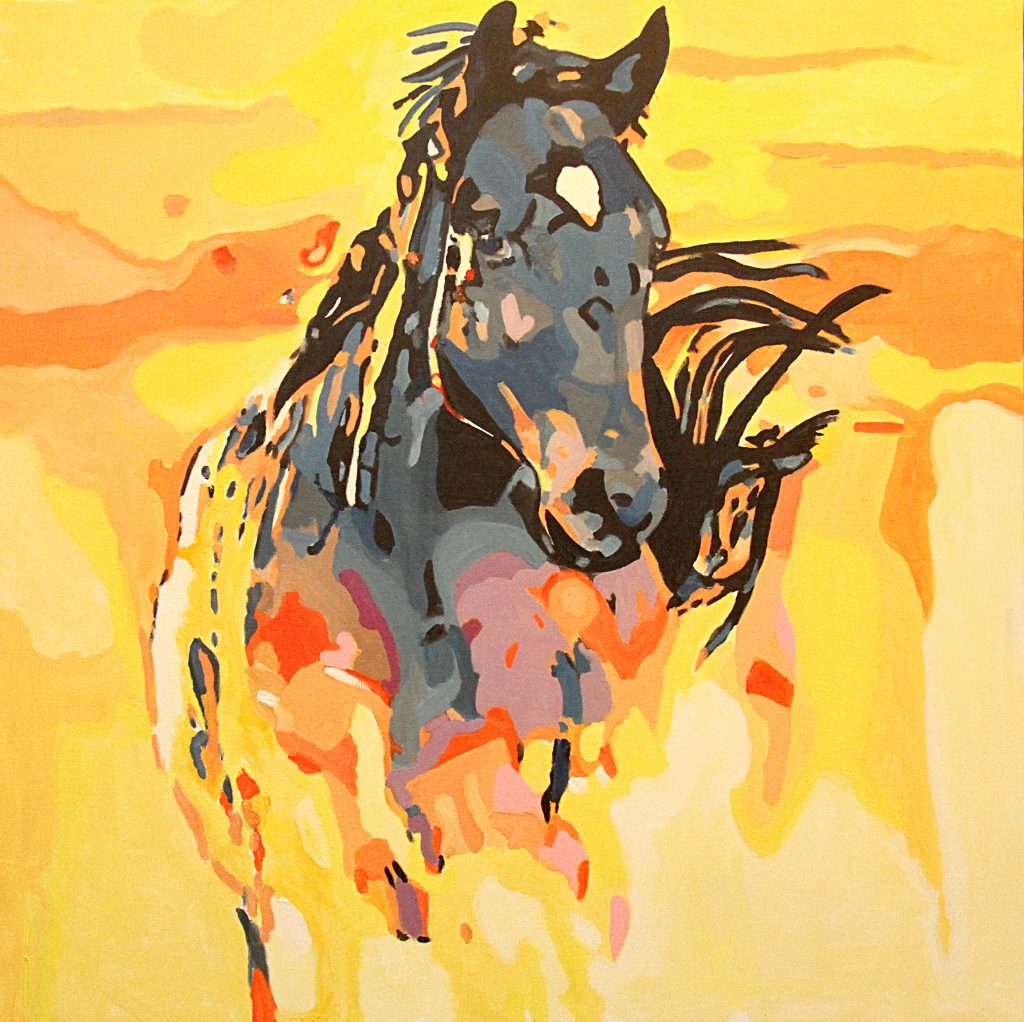 Copyright Alain Rousseau, Buveur de rosée (Dew drinker), on canvas, 80 x 80 cm, 2014
Copyright Alain Rousseau, Buveur de rosée (Dew drinker), on canvas, 80 x 80 cm, 2014
Similar to these smoking women, Alain Rousseau constantly expands his visual vocabulary. Still maintaining the format and his invented technique he formulates what communicates visually in the same manner. He created a circle of works called cocks (early 2014) and (end of 2014) the circle of horses. Both circles contain the same approach to what can be perceived consequently as a sensual pose which might be an imprint in the collective consciousness. If we see each of his works, we may fill in a personal memory. Maybe a pose resembles a coworker, another a public person or a family member, in any case though retrieved from our own memory. What is striking is that this happens not without irony, brought to color with a tactile, sensuous touch, expressed by color, varying the perception between personal Freudian projections. Still, there is a lot of ambiguity when it comes to narrowing down a person by that signature pose all of these portraits give off. Again, just like the smoking women, where only some of us enjoy having met them in person, but many of us can see them in visual artifacts, the cocks and the horses answer a visual pool directly. If you stand eye to eye with the cock, you can hear one scrabble the ground in order to find grain. You can hear the next one waking up your unconscious when creaking in the morning, at dawn, and you might be satisfied by your identification with the bossy cock ready to attack. Yes, indeed, it is a covey of cocks, although strictly male, and domestic to the human eye, within their own system, they do show great difference. By contrast, the manes of the horses, oh how many times do we see hands going through those manes. Some shine at their best personification, some best coiffed, others seem disheveled. Yet all of them carry the sparkle ignited by both irony and memory within. But beware. You may not share the same memory within one particular image. As Images projected are transmutable. Just like times.
Copyright Patrick Neithard
Patrick Neithard (*1971) is a cultural critic living in Zürich, Switzerland, graduated of Cambridge University and Zürich University of arts -– ZHdK Zürcher Hochschule der Kunst – 2004. “FH Designer” in Arts Media & Design.

